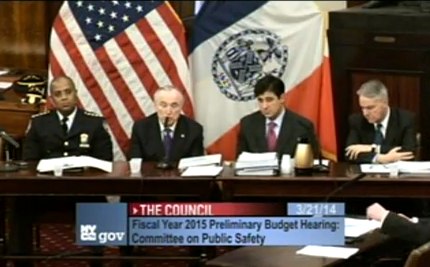
Police Commissioner Bill Bratton says NYPD is committed to Vision Zero, but the initiative to eliminate traffic deaths is not mentioned in the department's proposed budget, and it's not clear how the resources Bratton plans to dedicate to its implementation will be adequate to significantly reduce motorist violence.
"Safer streets must also mean safer roadways for pedestrians, bicyclists, and motorists alike," said Bratton, speaking at a preliminary budget hearing held last Friday by the City Council public safety committee. "New York's traffic fatality rate is the lowest among major U.S. cities. However, our streets are still deadly."
Bratton said total traffic fatalities are down by 30 percent this year compared to the same period in 2013, and pedestrian deaths have so far decreased 37 percent. "We of course won't rest until there are none," he said.
But sources who have seen NYPD’s proposed FY 2015 budget tell Streetsblog it contains no Vision Zero line items. Bratton told council members the department will expand the Highway Patrol and increase the number of investigators assigned to the Collision Investigation Squad, but he offered no specifics on head counts, and he gave no insight into additional measures police will take to reduce traffic crashes. At an earlier council hearing, Chief of Transportation Thomas Chan said the department has 200 speed guns on order to augment the current supply of 56 speed guns spread between 77 precincts.
In March 2013, then-commissioner Ray Kelly said NYPD would increase CIS staff by 10 investigators, from 19 to 29. As of last September, there were 22 investigators, with five more to be added "in the near future," according to John Cassidy, executive officer of the Transportation Bureau [PDF]. Cassidy also testified that NYPD created a new 13-member unit, the Collision Technician Group, to "assist CIS in the processing of collision scenes by performing evidence collection and analysis."
There were around 16,000 injury and fatal crashes involving NYC pedestrians and cyclists in 2013; NYPD investigated just 466 of them. A policy analyst for former comptroller John Liu estimated last year that NYPD would need 227 investigators to work all crashes that result in death or serious injury.
As far as enforcement, Chan told the council in February that NYPD will increase Highway Division staffing from 170 to 270 officers, but said enforcement on neighborhood streets would be done "at the precinct level."
“My goal is to change the mindset of the individual officers who are on daily patrol in the precincts. They are the ones who are going to make a difference on this,” Chan said. “I cannot rely on a speciality unit ... to achieve this goal.”
Again, the prevalence of reckless driving in NYC points to the need for a major increase in dedicated manpower and other resources. Though the number of precinct-issued summonses for dangerous moving violations is up from last year, the increase still accounts for only a tiny fraction of violations. If this is the extent to which the department intends to enforce the speed limit going forward, it only underscores the need for local control of the city's automated enforcement program.
During the Ray Kelly era, NYPD claimed it did not have the tools to crack down on dangerous driving and investigate more crashes. Now, the City Council is asking what it can do to provide those resources to the department. Without a commitment in the NYPD budget to the specifics of Vision Zero implementation, Bratton risks leaving that offer on the table.





